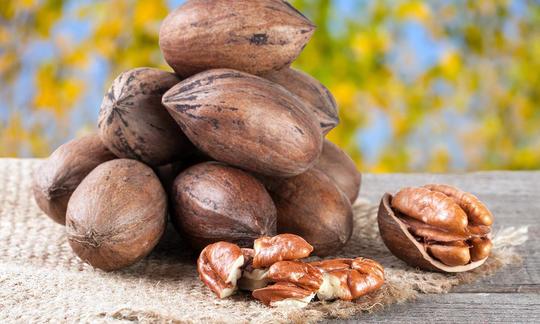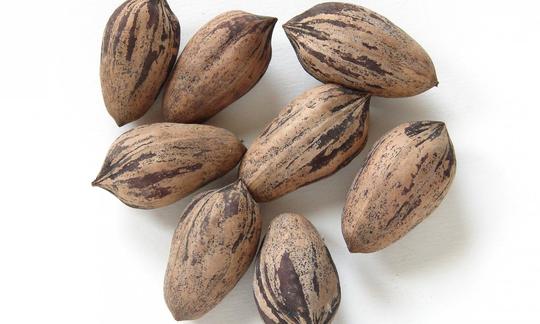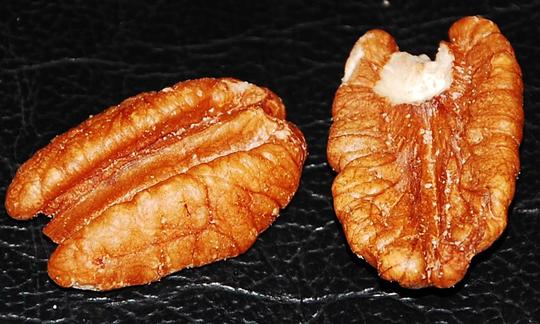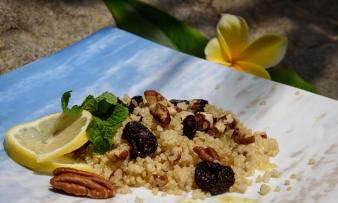Table of contents
Pecans ( Carya illinoinensis) taste pleasantly nutty and sweet when eaten raw. The pecan nut (but not pecan nut, peka nut, peka) is still relatively unknown in Europe, but has a lot to offer in terms of both food and health. Also available in organic quality ( bio).
Using pecans in the kitchen:
What is a pecan? The pecan is the fruit of the pecan tree, which belongs to the walnut family.
Appearance: Pecans are brownish with black spots, round and egg-shaped, their shell is thin and they have an average length of 2.5-6 cm. The two seeds are also brownish, but slightly lighter.
In the kitchen, pecans are used as an ingredient or decoration for cold and warm dishes. They are usually eaten raw, roasted or salted, but they can also be caramelized. Pecans are a good raw snack between meals or - in the form of pecan oil - as an addition to various dishes. The oil is mainly used in salads, but it should not be heated in order to preserve the ingredients. Pecans are a good ingredient for muesli (e.g. pea muesli), desserts, fillings or salads, but can also be found in processed products such as spreads and baked goods. A classic from American cuisine is 'pecan pie'. In Central Europe, pecans are mainly known from nut mixes. Pecan flour is also available on the market.
How do you crack pecans? The special thing about pecans is their soft, thin shell, which can be easily opened by hand without a nutcracker. Since the fatty acids they contain are very sensitive to oxidation, pecans should be cracked fresh and not left chopped or ground for long. More on this in the "Storage" chapter.
Vegan recipe for a pecan pie:
Ingredients : For the base: 200 g flour (white flour or wholemeal flour), 90 g vegan margarine, 60 g brown sugar, 1 pinch of salt, 2 tbsp soy cream, 1 tbsp ground hazelnuts ; For the filling: 100 g vegan margarine, 150 g brown sugar, 50 g pumpkin (flesh only), 220 ml soy cream, 400 g dark chocolate coating, 300 g pecans (shell removed, organic).
Preparation: Mix flour, sugar, salt, soy cream and vegan margarine into a dough, form a ball and wrap it in cling film and place it in the fridge for an hour. Then preheat the oven to 175 °C fan, grease the baking tin and sprinkle with hazelnuts. Roll out the dough, place it in the tin and press the edge lightly. Then place baking paper on the dough and bake blind for 30 minutes. Allow to cool. Dice the pumpkin flesh and cook in a little water for approx. 15 minutes, drain, puree and set aside. Then heat the soy cream with the sugar and pour over the roughly chopped chocolate (couverture), stir and add the margarine. Grind 100 g of the pecans. Fold the ground pecans and pumpkin puree into the mixture, spread everything on the base and cover with the remaining pecans. To achieve a firm consistency, place the vegan pecan pie in the refrigerator.
Vegan pecan brownies recipe:
Ingredients: ½ cup sweet potato puree (about 150 g sweet potatoes, peeled, boiled and mashed), 200 g flour, 120 g cocoa, 1 tsp baking powder, ½ tsp salt, 50 g shelled pecans (organic), 100 g grated or finely chopped chocolate, 200 g sugar, 125 ml rapeseed oil (refined), 125 ml maple syrup, 2 tsp vanilla extract, 180 ml soy milk.
Preparation: First, prepare the sweet potato puree and let it cool. Sift flour, cocoa, baking powder and salt into a bowl and add the pecans, chocolate shavings and sugar. In another bowl, mix the oil, maple syrup, vanilla, soy milk and sweet potato puree with a whisk. Then put both mixtures together and pour the relatively liquid dough into a rectangular mold (20x30 cm), bake it for 30 to 35 minutes at 180 °C top / bottom heat. The dough is ready when the surface can be easily pressed in with your finger so that it arches up elastically again. The inside of the finished brownie dough should remain slightly moist. Allow the vegan brownies to cool in the mold, cut into pieces and serve.
Vegan recipes with pecans can be found under the note: " Recipes that have the most of this ingredient ".
| Not only vegans or vegetarians should read this: Vegans often eat unhealthily. Avoidable nutritional mistakes. |
Shopping - where to buy pecans?
Supermarkets and wholesalers such as Coop, Migros, Denner, Spar, Aldi, Lidl, Rewe, Edeka or Hofer sell pecan nuts (that is: shelled pecans), but sometimes also whole pecans with shells. In health food stores, organic shops and organic supermarkets (such as Denn's Biomarkt, Alnatura) or in drugstores, specialty shops or online retailers, the nuts can be found in organic and raw food quality. In addition to natural, raw and unsalted pecan nuts, you can also buy roasted, salted, caramelized and seasoned pecan nuts - single variety or in nut mixes. Thanks to their growing areas north and south of the equator and the long storage times, pecans are in season all year round in Europe. However, they are increasingly found on the shelves at Christmas time, as the harvest season in North America lasts from October to December. South of the equator, the main harvest season starts in May, but only a small proportion of the nuts come from there. 1
Found in the wild:
South of the Mississippi there are natural forests of pecan trees, where trees are up to 300 years old. 2
Storing pecans:
Unpeeled, raw pecans can be kept for up to a year if stored in a dry, cool place. However, it is advisable to put them in the fridge or freezer after six months. Opened or peeled pecans will stay fresh for around six months if stored in the fridge. Pecans can be stored in the freezer (peeled or unshelled) for longer periods. The oil they contain can otherwise make the nuts taste rancid or moldy at high temperatures, temperature fluctuations, humidity or when stored in the air. 3 An airtight container provides additional protection and also prevents the absorption of bad smells.
Pecan ingredients - nutritional values - calories:
Pecans are one of the higher calorie nuts with 691 kcal/100g. The fat content of pecans is 76%, of which around 30.9% is saturated fat (6.2 g). This proportion of saturated fat is comparable to that of cashews (38.9%). The sugar content of carbohydrates is 4 g (out of 14 g) and the fiber content is quite high at 38.4%. Pecans contain around 10% protein. 4
Pecans have a fatty acid ratio of LA:ALA (21:1), which is not necessarily bad for nuts, compared to almonds, for example. Almonds contain around 12% of inflammatory omega-6 linoleic acid (LA) and practically no healthy omega-3 alpha-linolenic acid (ALA) (less than 0.01 g). The value for almonds can vary greatly, but the ratio of >999:1 is bad compared to the recommendation of the Federal Nutrition Commission. which aims for <5:1. The walnut, related to the pecan, has a good ratio of 4:1, and macadamia nuts are at 6:1. 4
Pecans are particularly rich in manganese, which is the highest value of essential nutrients in the pecan. This is 4.5 mg/100g and is comparable to the values ofpumpkin seeds (4.5 mg) or macadamia nuts (4.1 mg), but still considerably lower than, for example, pine nuts (8.8 mg). 4 Cells need manganese to provide energy and it helps build bones, cartilage and connective tissue. 5
The zinc content is also worth mentioning (4.5 mg), similar to that of psyllium husks (4.8 mg), but lower than that of driedpumpkin seeds (7.8 mg). 4
Do pecans have vitamins? One positive thing to mention is the relatively high content of vitamin B1 with 0.66 mg/100g, comparable to that of hazelnuts (0.64 mg), but lower than that of sunflower seeds (1.5 mg). Vitamin B1 (thiamine) is involved in the transmission of stimuli in the nervous system and in the production of energy in carbohydrate metabolism. Walnuts have a higher content with 0.34 mg/100g. 4 Other vitamins in pecans include vitamin B6 and vitamin B5 (pantothenic acid).
Vitamin A and vitamin E, calcium, potassium and magnesium are also positive. Magnesium is important for muscle activity and regulates cellular excitability and can therefore help in stressful situations. Calcium is important for bones and teeth and potassium is also relevant for the transmission of stimuli in the nervous system. 1
The complete ingredients of pecans, the coverage of the daily requirement and comparison values with other ingredients can be found in our nutrient tables. In the article Nutrients explained you will get a detailed insight into the topic.
Health aspects - effects:
How healthy are pecans? Pecans contain a high proportion of epigallocatechin-3-gallate (EGCG), a polyphenol that has a number of health-promoting aspects. Moderate, regular consumption of pecans (especially combined with foods rich in ALA) can minimize inflammation. It can also counteract an inflammatory diet (rich in saturated fatty acids), as is often found in Western cultures. According to studies, pecans are said to have a positive effect on metabolic disorders, cardiovascular diseases 6, on cholesterol levels (a high proportion of monounsaturated fatty acids is said to reduce cholesterol levels) and obesity. 7,8 The high proportion of fiber also promotes digestion, satiety and excretes toxins and harmful substances. 9
Are pecans healthier than walnuts? If you compare the ingredients of the two nuts, you can see the following differences: The walnut has less sugar in its carbohydrates (2.6 g compared to 4 g for the pecan). In addition, the walnut contains more protein (15 g) than the pecan (9.2 g). As mentioned above, the manganese content is also significant (3.4 mg for the walnut compared to 4.5 mg/100g for the pecan). The raw walnut stands out particularly in terms of the ratio of omega-6 to omega-3 fatty acids. In particular, the proportion of alpha-linolenic acid (ALA) is 10 times higher than in the raw pecan. 4 Essential amino acids are also better represented in the walnut. A comparison with other nutritional values shows that the two nuts are otherwise very similar. Since variety is important for a balanced diet, it is advantageous not to commit to just one particular type of nut. It is best to include a variety of nuts and seeds in your daily meals, taking the LA:ALA ratio into account, as long as they are unroasted and unsalted.
Dangers - Intolerances - Side effects:
Some people are allergic to pecan kernels; allergic reactions can also occur to pollen from pecan trees. However, these are very rare in western areas because there are very few trees. 10
Overweight people in particular should be aware of the high energy content of pecans, 6 especially if the nuts are consumed in processed form (e.g. in cakes, caramelized or salted).
Many nuts, especially those from tropical and subtropical regions, may be contaminated with aflatoxins. Molds such as Aspergillus flavus and Aspergillus parasiticus produce genotoxic and carcinogenic mycotoxins as metabolic products. The current maximum value for aflatoxin B1 is 2 µg/kg. 11 Contamination is hardly noticeable externally or in taste. Ground nuts are more frequently contaminated than whole nuts, and aflatoxins can also be found in processed products. However, the Federal Institute for Risk Assessment classified the aflatoxin contamination in nuts as rather low and sees no specific health risk for consumers. 12
Occurrence - Origin of pecans:
The origin of the pecan tree is not entirely clear. As Native Americans collected pecans, they spread them further, which is why it is difficult to prove where they originally came from. The origin of the pecan is thought to be in the Mississippi Valley in the southeast of the USA or in the regions of Kansas, Texas and Mexico. 13 Today, there are both original trees as well as seedlings and intermediate variants. 14 North America produces around 92% of pecans ( Carya illinoinensis), over three quarters of them in Georgia, New Mexico and Texas. 15,16 Outside North America, Hawaii, Australia, Brazil, China, Israel, Peru and South Africa cultivate pecan trees.
Growing in the garden or as a potted plant:
Pecan trees need a warm climate, enough space and soil that is not too moist. It is best to plant them in early autumn. Sufficient water is important, but you should avoid waterlogging. The first pecans can be harvested after five to eight years. The nuts are ripe when they fall to the ground and their shell opens. Seeds from specialist retailers are very difficult to germinate in pots, which is why it is a good idea to buy a pre-grown tree. 17
Cultivation - Harvest:
The first variety of pecan was grafted in Louisiana in 1846. Pecan trees have been grown in the USA ever since. 13 The trees are around 30 to 50 metres tall. Cultivated trees are usually bred to be extra short. 18 They bear fruit alternately, which means that the harvest is particularly plentiful every two years and rather poor in other years. 14 The tree can tolerate temperatures as low as -20 °C, but can also survive periods of extreme heat. 14,19 The wind pollinates the flowers of the pecan tree. Insects do not fly to them. As female and male flowers are in different places on the same tree and do not open at the same time, it is important to plant different varieties together to ensure pollination of the trees. 13 The pecan belongs to the genus Carya, whose seeds have an outer, four-ribbed, fleshy shell. This dries out and bursts open when the nuts are ripe. The kernels, with the inner shell surrounding the nut, fall to the ground. As with walnuts and almonds, mechanical harvesting is done using branch shakers that shake the nuts from the tree and special machines that then pick up the fallen nuts. Most pecans are then shelled in a factory and air-dried so that they have a water content of about 4.5%. 19 Further treatment with propylene dioxide helps to kill insects. The nuts are then sorted by size and prepared for sale.
Risk of confusion with pecans:
There is only a risk of confusion with walnuts due to the very similar appearance of shelled nuts. In addition, the two nuts are quite closely related.
General information:
The pecan nut ( Carya illinoinensis) comes from the walnut family (Juglandaceae) and among these from the genus hickory ( Carya). All fruits of this genus, with the exception of pecans, are called hickory nuts. 19 The pecan tree is related to the common walnut ( Juglans regia). The word carya is derived from the Greek word "karyon", which means nut or kernel (in the plural karya = nuts, kernels). Traders brought the nuts to the Atlantic coast as "Illinois nuts", which gave rise to the name illinoinensis, even though the nuts do not originate from Illinois. 13
The pecan tree has been the official state tree of the US state of Texas since 1919. 20 The Algonquian Indians made "hickory milk", a creamy liquid from the nuts. 13 The pecan tree is particularly long-lived and can reach an age of up to 300 years. 1
Alternative names for pecans:
In English, the pecan nut is called pecan or pecan nut, which also corresponds to an alternative German spelling: Pecannuss.
In German you will often find spelling mistakes like Pekanuss (Pekanüsse), Pecanuss (Pecanüsse), Pekannus, Pecanus or even separate spellings like: Pecan Nuss (Pecan Nüsse), Peka Nuss (Peka Nüsse), Pekan Nuss (Pekan Nüsse), Peca Nuss.
Key words for the use of pecans:
Pecan oil is sometimes used to care for the skin or as a massage oil. 18 Pecan oil is extracted from the seeds of the pecan tree - either by extraction with ether or by cold pressing. The oil is light, clear, yellowish and smells nutty. 14 The crushed pecan shell is also used in industry as an abrasive. The wood can be used to make veneers, flooring, paper and decorative paneling. 13,19
Literature - Sources:
Bibliography - 20 Sources
| 1. | Nucis.de Die Pekannuss. |
| 2. | Mahlerundco.ch Bio Pekannüsse wild. |
| 3. | Isteshaltbar.de Werden Pekannüsse schlecht? |
| 4. | USDA United States Department of Agriculture. |
| 5. | Verbraucherzentrale.de Mangan – und die Ernährung reicht. |
| 6. | Brehme U. Stellenwert von Nüssen in der Ernährung für die Prävention von Herz-Kreislauferkrankungen; Ernährungsumschau 49;2:44. 2002. |
| 7. | Atanasov AG, Sabharanjak SM, u. a. Pecan nuts: A review of reported bioactivities and health effects. Trends in Food Science & Technology. Januar 2018;71:246–57. |
| 8. | Eagappan K, Sasikumar S. Therapeutic effects of nuts in various diseases. International Journal of Recent Scientific Research. 2014. v.5. n.1:190-197. |
| 9. | Leitzmann C. Ballaststoffe. Ernährung und Fasten als Therapie. Berlin, Heidelberg Springer. 2010:61-71. |
| 10. | Allergiefreie-allergiker.de Pekannuss Allergie: Symptome, Behandlung und Tipps für Allergiker. |
| 11. | Verordnung EG Nr. 1881/2006 zur Festsetzung der Höchstgehalte für bestimmte Kontaminanten in Lebensmitteln hinsichtlich Aflatoxinen. 2010. |
| 12. | BfR Bundesinstitut für Risikobewertung. Aflatoxine. |
| 13. | Rollenbeck R. Carya illinoinensis – Pekannussbaum, Pekan (Juglandaceae). Jahrb. Bochumer Bot. Ver. 2014. |
| 14. | Lebensmittel-warenkunde.de Pekannuss. |
| 15. | Agmrc.org Agricultural marketing resource center: Pecans. Marzolo G. 2015. |
| 16. | Kiralana S S, Kiralana M, Ozkanb G. Chapter 46 - Cold pressed pecan (Carya illinoinensis) oil. International Nut and Dried Fruit Council Foundation. 2018. |
| 17. | Gartenjournal.net Pekannüsse pflanzen - Warmes Klima bevorzugt. |
| 18. | Biologie-schule.de Pekannussbaum. Steckbrief. |
| 19. | Lüdders P. Pekannuss (Carya illinoinensis) - Botanik, Anbau und Verwendung einer subtropischen Obstart mit Zukunft. Erwerbs-Obstbau. 2004; 46:52–58. |
| 20. | Texasproud.com The Texas State Tree: Pecan. |













Comments